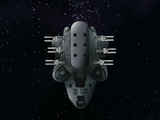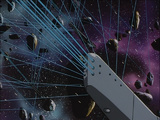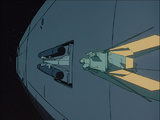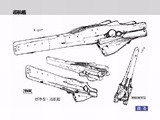Imperial cruiser (788 UC era)
From Gineipaedia, the Legend of Galactic Heroes wiki
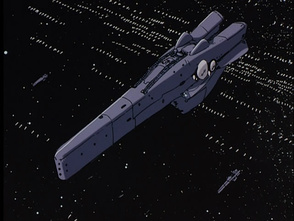 Imperial standard cruiser (799 UC (1 NIC / 490 IC / 3599 CE)) | |
| Affiliation: | Galactic Empire |
| Type: | Cruiser |
| Length: | 576 metres(FFC4) |
| Width: | 141 metres(FFC4) |
| Height: | 144 metres(FFC4) |
| Armament: | 6 neutron beam cannons 11 port cannons 11 starboard cannons |
| Crew: | 670(FFC4) |
This Imperial cruiser (Japanese: 巡航艦) design served as the standard cruiser design of Imperial fleets from the late stages of the Alliance–Imperial War to at least 801 UC (3 NIC / 492 IC / 3601 CE).
Contents |
Design
The standard cruiser design had four separate engines mounted on the main hull.
In terms of armament, the ship mounted six beam cannons in the bow and at least eleven cannons on both the port and starboard side. In addition to this armament, the cruiser had at least two kinds of retractable weapons mounted on the port hull - a missile launcher with two rounds ready to fire, and a rotating turret. (LOGH: 'First Battle')
In addition, the cruiser could release mines from hatches in the stern. (RET: 'Chapter III')
The vessel carried six Walküre fighters with 3 launch ports on either side of the main hull. (RET: 'Chapter II')
Role and Capabilities
The standard cruiser design fought in all known fleet battles from at least 788 UC (479 IC / 3588 CE) to 801 UC (3 NIC / 492 IC / 3601 CE), in large numbers. A fleet of 2,000 ships under a Rear admiral (i.e. only a single unit of a much larger fleet) could be expected to include anywhere from 400 to 500 cruisers. (LOGH: 'First Battle')
In addition to its role in fleet battles, cruisers were also sent out on patrols and special missions in enemy territory. (TBT: 'Part One'; RET: 'Chapter I').
The standard cruiser, unlike its Alliance counterparts, could enter planetary atmospheres and land on the surface. (LOGH: 'Farewell, Distant Memories')
Gallery
Starboard (800 UC (2 NIC / 491 IC / 3600 CE)) |
Launching Walküren (792 UC (483 IC / 3592 CE)) |
Cannons firing (800 UC (2 NIC / 491 IC / 3600 CE)) |
Stern (795 UC (486 IC / 3595 CE)) |
Missile launcher (798 UC (489 IC / 3598 CE)) |
Cannon turret (798 UC (489 IC / 3598 CE)) |
Appendices
Licensed sources
This standard Imperial cruiser design was in use for nearly half a century. It was designed to be a balance of firepower, endurance, and mobility. It was a multi-purpose ship and could function in a wide variety of roles.
Its prow mounted 6 medium calibre neutron beam cannons. Situated near them were reverse thrusters, capable of rapidly decelerating the ship. As point defence against enemy small craft, gatling laser mounts were fitted, spaced around the ship.
Immediately aft of the cannons was a modular space that could be fitted out to suit the mission. Most commonly for combat, this space housed a large missile launcher system. Another option was a hangar module for 6 additional Walküre fighters. When the cruiser had to act as a fast transport, this space could fit a cargo bay module for supplies or a troop transport module for over 1000 passengers. Another option was a medical module with simplified stripped down hospital facilities, converting the cruiser into a hospital ship. Even a theatre module was available, filled with entertainment facilities, for important VIP passengers.
At the rear of the ship were 4 engines, arranged 2 to a side. When the cruiser was first designed, these engines were newly introduced models with up to 10% improvement in propellant consumption compared to older engines. Fitting these increased the cruiser's patrol endurance and operational range. The lower two engines were also used in atmosphere, with air intake ports near them. Air would pass in, be heated, and expelled out the rear to propel the ship forward.
In the lower ventral bulge, the cruiser fitted the majority of its navigational and sensor equipment, as well as room for 3 Walküre fighters. The extensive sensor suite allowed for patrols in far flung frontier systems where existing navigational data might be lacking, as well allowing the cruiser to operate as a picket in large scale fleet movements. (Fleet File Collection Vol.4, Data Book: Mechanic & Seiyū Encyclopaedia, p. 170)
Apocrypha
DVD features
A sketch of the Imperial cruiser appears in the extra features of the DVD box set.

